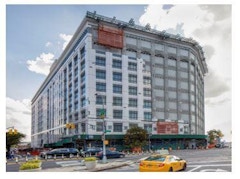
51 results
-
 The history of high performance facades and glazing has been a tale of attempting to manage the conflicting requirements of, on one hand inviting…
The history of high performance facades and glazing has been a tale of attempting to manage the conflicting requirements of, on one hand inviting… -

Sustainable Silicone
- Paper by Jon Kimberlain, TS&D Scientist Adrienne Bowman-Grittini, Senior Technical Service and Development Specialist Stanley Yee, TS&D Scientist
Silicone materials have a long history in high performance building projects. Known for durability, they can reduce a building’s carbon footprint by… -

Reduce, Reuse, Reclad
- Paper by Daniel Nauman, AIA, NCARB, LEED AP, Senior Associate Jessica Santonastaso, Associate Jennifer Sze, RA, USGBC LEED AP, Principal and Director of Special Inspections
Kintsukuroi, the Japanese art of repairing broken pottery with powdered precious metal, is a practice of celebrating the life and history of an… -

Ginza Six
- Paper by Katsuhiko Muramoto · Junko Owada
Tokyo’s prestigious Ginza District, is home to innovative architectural design. One of the most recent examples is Ginza Six (GSIX), the largest
-
Balustrade Design Loads
- Paper by Richard Green, SE, PE, P.Eng, CPEng, IntPE, APEC Engineer, M.ASCE M.IEAust, Founding Principal Andrew Crosby PEng, Principal Terrence McDonnell, Associate Principal
A review of balustrade practices from around the world, and why practices in United States and countries using ICC code/ASCE 7 designs are failing to… -

Structural Silicone Glazing
- Paper by Jon Kimberlain, Senior Scientist Yvonne Diaz, Senior Research Specialist Andrew Dunlap, Principal Adrienne Bowman-Grittini, Technical Service & Development Leader
The recent 50 year anniversary of the first use of silicone sealant in a 4-sided structural silicone glazing application marks a sustainable and… -

Bringing an Icon Into the Future: Willis Tower
- Paper by Stephen Katz
Few buildings are as iconic as Willis Tower. Generations of Chicagoans have a collective memory of this building playing a role in their entire
-

Fully Tempered Glass in Spandrel Applications
- Paper by Stéphane Hoffman, PE · Lawrence D. Carbary
Recent years have seen an increase in the use of insulated glazing units (IGUs) in spandrel applications to visually blend the appearance between the
-
Sustainable simplicity and the future of exterior wall for research and education buildings
- Paper by Carl Knutson · Andrei Koshelev
Today, there is a shift towards sustainable simplicity in facades, embracing material innovations and thermal design strategies for long-term
-

Lithic Revival
- Paper by Alex Terzich,
The recently completed Capital One Hall performing arts center located in the Washington DC metro area is defined by a pleated exterior of glass and… -
Terracotta 1912 to 2018
- Paper by Carol Loewenson, FAIA, LEED AP · Stephen Dietz, AIA, LEED AP
Center Three is a 100-year-old, one million square-foot building in Long Island City, New York that was constructed over the course of one year. It
-
Patchwork
- Paper by Alexander G. Worden, AIA
It may be difficult for modern man to believe that what is known as handicraft was once the advanced manufacturing of the day. These techniques were
-

Integrating Soft Robotics into Architectural Assemblies
- Paper by Vera Parlac, Associate Professor
The project described in this paper explores the integration of custom-made soft robotic muscles into a component-based surface. This project is part… -
Curved Forming Panel Facades
- Paper by Roger Schroeder
The performative and visual aspects of curved forming/bending thin “formable” planar materials is explored. Early tests for deflection indicate that
-

Historical Evolution of Responsive Facades
- Paper by Negar Heidari Matin, Ph.D. Candidate, LEED GA, Ali Eydgahi, Ph.D., Shimming Shyu, Ph.D., RA, LEED AP BD+C, Payam H. Matin, Ph.D.,
Responsive facade system is considered a major component of high-performance building envelope that is capable of responding to environmental stimuli… -

Renewing Historic Facades
- Paper by Christine Reynolds, PE · Hans Thummel, AIA, LEED AP BD+C
As the first phase of a $4 billion dollar, 180-acre, 60 building government preservation project in Washington DC, this case study reviews the
-
Comparison of Historical Weathered Annealed Glass Failure Data to ASTM E1300
- Paper by Nabhajit Goswami; Student, ngoswami@mtu.edu Stephen M Morse; Assistant Professor, Civil and Environmental Engineering Assistant Professor, Mechanical Engineering-Engineering Mechanics Michigan Tech University, smmorse@mtu.edu
Historical published weathered annealed failure data consisting of 13 samples were collected and glass failure prediction model surface flaw… -

Preserving a Historic Facade
- Paper by Maria Mohammed, S.E., Design Engineer John Fidler, RIBA, Intl Assoc AIA, FRICS, FSA, FRSA, FIIC, FAPT, President
Environmental and socio-economic benefits of sustainable preservation have become apparent most recently in the restoration of the historic former… -

Retrofit Options for Historic Facades
- Paper by Carrie Davis, P.E., LEED Green Assoc., George Kantrales, Ph.D., Matt Barsotti, Andrew Schoenheit, Ty Vandergriff,
Building design criteria requires that government buildings be designed for a variety of extreme loads including blast, hurricane, and impact… -

The Carbon Footprint of Aluminum Fenestration
- Paper by Tom Bougher, Director of Applied Research Richard Braunstein, Vice President of R&D
The historical focus on reducing the carbon footprint of a building has recently shifted to include more emphasis on embodied carbon, the carbon…


